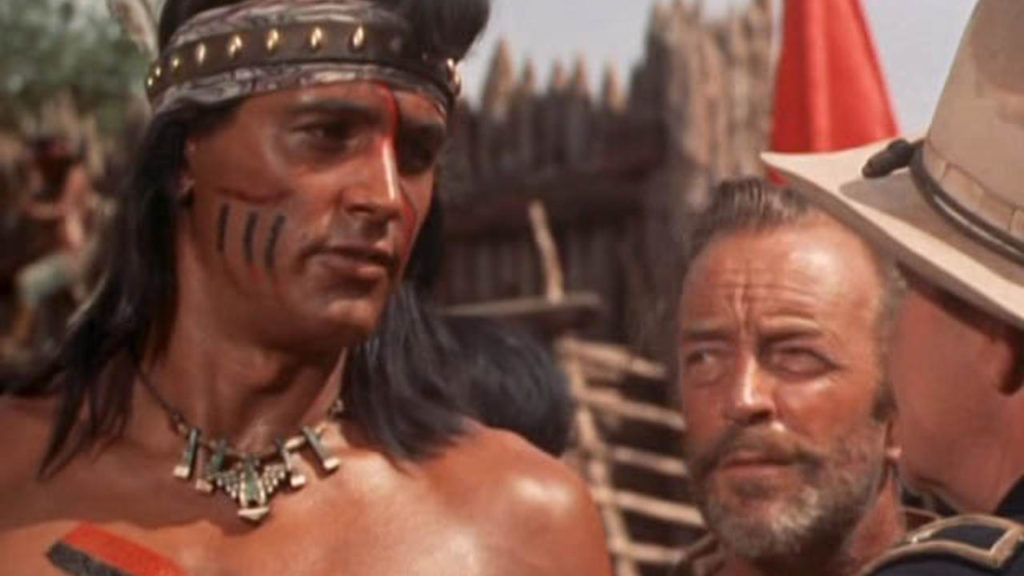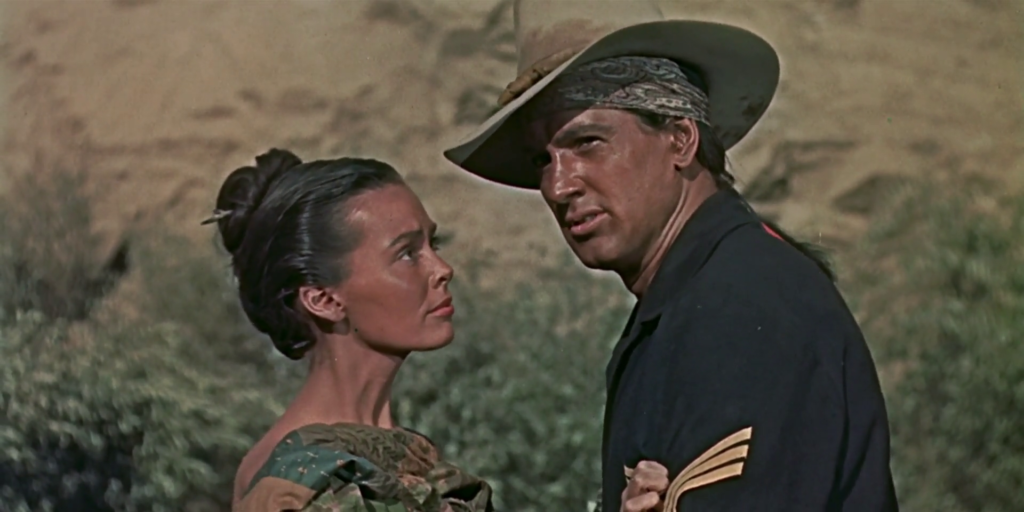Rock Hudson Stars as Historical Native American Chief in Action-packed 3-D Western from Douglas Sirk.
DIRECTED BY DOUGLAS SIRK/1954
BLU-RAY STREET DATE: MAY 26, 2020/KL STUDIO CLASSICS

Sometimes what’s right about any given older film goes a long way in our willingness to overlook what we now view as its sins. A big sin these days is representation done wrong. For example, white actors playing native Americans.
Taza, the son of Cochise, is indeed a historical figure known to have taken his father’s place as principle chief of the Chihuicahui Apache people upon his death in 1874. Taza’s rule, however, was short lived. In 1876, he ended up dying of pneumonia while taking part in an honorary visit to Washington D.C. The film Taza, Son of Cochise avoids detailing that fate, instead allowing a happier ending of sorts. I can’t vouch for the historical accuracy of most of the film’s events, but I am rather certain that Taza himself did not resemble Rock Hudson in deep tan makeup.
Looping back around to this review’s opening thought about Caucasian actors in “redface”, this was, of course, an all too common practice in this time of mass production of the Western genre. Taza certainly wasn’t the first film to go this route in terms of casting, and it certainly wouldn’t be the last. For an example of a film that remains elevated for its many virtues in spite of this, look no further than John Ford’s heavily venerated The Searchers (1956).
Though directed by a name filmmaker (Douglas Sirk is today revered for his work in melodrama, particularly for his sharp use of color and fashion as subtly volatile elements) and starring an unflinchingly committed Rock Hudson, a rising leading man of the day, Taza is no Searchers. Shot in a handsomely refined 3-D process as something of an event picture (though under eighty minutes long, it has an intermission), Taza, in its many battle scenes and steady action, can’t shake its potboiler tendencies.

But, maybe it doesn’t need to? Sirk was apparently quoted as naming Taza, Son of Cochise his favorite of his own films, in that he thrilled to have that golden opportunity that almost every director longs for, the chance to make a Western. (Hudson, on the other hand, once singled this film out as “crap”). Being a major 3-D picture for Universal Studios in 1954, no promise of prestige was ever made. In fact, the movie displays a shocking degree of onscreen violence for its time. Beginning with a jarring arrow-to-the-chest death of a teenage settler girl played out in close-up, there’s no shortage of impalings, stabbings, crushings or shootings; many spears and rocks are hurled directly at the camera.
In a moment when 3-D filmmaking was in desperate need of reconfiguring (audiences re already losing patience with the headaches and fatigue that earlier versions of the process tended to induce), this level of visceral gimmickry successfully executed helped make Taza something more than watchable. (According to a fascinating and highly informative special nineteen-minute “slideshow commentary” bonus featurette with 3-D historian Mike Ballew, Universal publicity released a statement saying that a mirror apparatus for one of the cameras was accidentally destroyed while filming just such a shot). It’s as though Sirk was actualizing all of the purely emotional violence of the melodramatic masterpieces he’d soon be making with Hudson. (Magnificent Obsession, All That Heaven Allows, Written on the Wind).
The story itself (highly fictionalized in nature) depicts Taza siding with the U.S. Cavalry despite the wishes of tribal elders and a more hostile faction led by the troublesome Geronimo (Ian MacDonald, in red makeup). Amid the upheaval incited by Taza showing up in a blue Cavalry uniform (among other things), he decides that it’s time he married Oona (Barbara Rush… in makeup), daughter of the rigid Grey Eagle (Morris Ankrum, yes, again, in makeup) and unclothed swimmer of the lake. But he soon discovers that even their mutual love is not enough to ensure such a thing.

Kino Lorber Studio Classics has once again teamed up with the good people (not to mention devoted researchers) at the 3-D Film Archive to present both the 2-D and 3-D versions of the film. (It was originally released both ways to theaters, depending on the market). The Blu-ray contains the option to watch the film either way, but one must have 3-D-capable equipment to support the stereoscopic version. The transfer of 2-D version looks reasonable at best, sometimes strangely dark; other times a bit worn. That said, it’s quite likely that this is as good as Taza is likely to look. The only noteworthy bonus feature is the aforementioned slideshow commentary, which is absolutely worth one’s time. Fans of Rock Hudson, Douglas Sirk, vintage 3-D, and classic Westerns will want to check out this Blu-ray.
Much of Taza, from its particularly egregious representation issues (something that even then, studio publicity took measures to quell, as they often promoted the involvement of authentic Native Americans as extras in films, this being no exception) to the broken English the Indians speak to the depicted nobility in Taza’s siding with the Cavalry, has of course aged rather badly. But, while Taza, Son of Cochise’s positives don’t bring it to a place of transcending its negatives, it is, strictly speaking as an action-Western, far from unwatchable.

